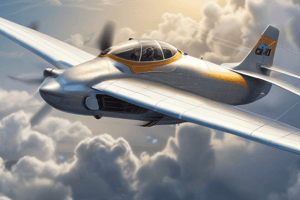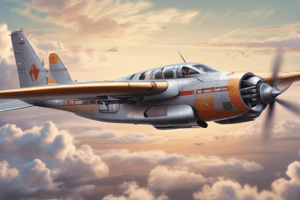Podcast
Questions and Answers
What factors determine the lift coefficient (CL) and drag coefficient (CD) during take-off and landing?
What factors determine the lift coefficient (CL) and drag coefficient (CD) during take-off and landing?
- Only the configuration of the aircraft
- The angle of attack (AOA) and the configuration of the aircraft (correct)
- The speed of the aircraft and wind conditions
- Only the angle of attack (AOA)
What happens to the parasitic drag (CD0) when the aircraft is in landing configuration?
What happens to the parasitic drag (CD0) when the aircraft is in landing configuration?
- It decreases significantly
- It increases (correct)
- It becomes negligible
- It remains unchanged
Why can’t an idle descent be used during an ILS approach?
Why can’t an idle descent be used during an ILS approach?
- The landing configuration necessitates the use of thrust (correct)
- An idle descent requires more drag
- Idle descent is unsafe at low altitudes
- Idle thrust is insufficient for landing
What determines the relationship between the lift and drag forces during the flare arc?
What determines the relationship between the lift and drag forces during the flare arc?
How do flap configurations affect an aircraft's performance during takeoff and landing?
How do flap configurations affect an aircraft's performance during takeoff and landing?
What trend occurs to the induced drag (CDi) as the aircraft's lift coefficient (CL) increases?
What trend occurs to the induced drag (CDi) as the aircraft's lift coefficient (CL) increases?
What is the primary reason for retracting flaps after takeoff?
What is the primary reason for retracting flaps after takeoff?
What happens to the total drag when the aircraft transitions from clean configuration to landing configuration?
What happens to the total drag when the aircraft transitions from clean configuration to landing configuration?
Flashcards are hidden until you start studying
Study Notes
Landing Performance
- CL (Lift Coefficient) and CD (Drag Coefficient) during take-off and landing are influenced by AOA (Angle of Attack) and aircraft configuration (flaps, slats, spoilers, gear).
- AOA considerations are excluded from the flow separation up to and including stall conditions.
- Parasitic drag (CDO) remains unaffected by AOA changes.
- The relationship can be represented by a valid parabolic equation.
Approach Distance
- Powered descent is necessary during ILS approaches due to activated landing configurations (flaps, slats, gear), making idle descent unfeasible.
- Flaps are strictly used during take-off and landing due to their significant impact on drag.
- Flaps should be retracted immediately after take-off to reduce noise levels for nearby populations and improve fuel efficiency.
- The increase in landing configuration causes a rise in parasitic drag (CD0).
- Aerodynamic drag components are visually represented:
- Brown line (CD0), green line (CDi), and dark green line (Total Drag) reflect the clean aircraft configuration.
- The pink line indicates increasing parasitic drag (CD0) when landing configuration is deployed.
- Induced drag (CDi) rises with increasing lift coefficient (CL), while the Oswald factor experiences a slight decrease due to changing wing shape; however, the green line remains relatively stable.
- The transition from a clean configuration (dark green line) to landing configuration (blue line) results in the lowest speed condition.
Flare Distance
- Forces parallel to True Air Speed (TAS) balance, resulting in zero net force (D - T = W).
- Forces perpendicular to TAS equate to centripetal force during the flare phase, maintaining a consistent flight path.
- Limitations of the flare formula include:
- Requirement for a constant radius throughout the flare arc.
- The decrease in angle Y during the flare necessitates increased lift and AOA while maintaining constant speed.
Studying That Suits You
Use AI to generate personalized quizzes and flashcards to suit your learning preferences.




